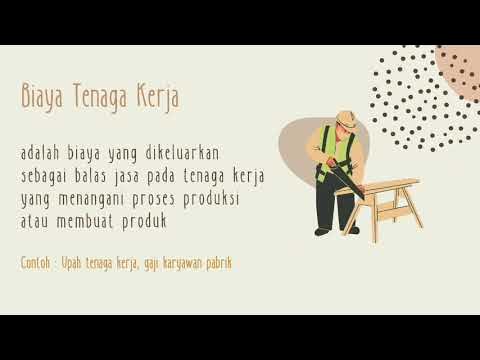(FACIL) Materiales Directos, Mano de Obra Directa, Costos Indirectos de Fábrica
Summary
TLDRThis lesson teaches the fundamentals of production costs, focusing on the three key elements: direct materials, direct labor, and factory overhead. It explores how materials are transformed into products, the human effort required, and the indirect costs involved. Students learn to classify costs into direct and indirect categories, with examples such as wood and labor in guitar manufacturing. The lesson culminates in the formula for calculating total production cost: Direct Materials + Direct Labor + Factory Overhead. This clear explanation provides a strong foundation for understanding cost analysis in manufacturing.
Takeaways
- 😀 The cost of production includes the cost of materials and the cost of converting those materials into finished products.
- 😀 The three main elements of production costs are raw materials, labor, and factory overhead costs.
- 😀 Raw materials are materials transformed through physical or chemical operations to become finished products.
- 😀 Labor refers to the human effort used to transform raw materials into finished products, such as workers cutting wood or assembling products.
- 😀 Factory overhead costs are the indirect costs that cannot be fully identified or quantified with specific products, like factory rent or electricity.
- 😀 Raw materials can be classified as direct or indirect. Direct raw materials are those that can be identified and quantified in the final product.
- 😀 Direct raw materials, such as wood in guitar manufacturing, are identifiable and measurable in the final product.
- 😀 Indirect raw materials, like glue used in guitar manufacturing, are difficult to identify or quantify in the finished product.
- 😀 Direct labor involves workers whose efforts can be directly identified and quantified in the final product, such as those cutting wood or assembling guitars.
- 😀 Indirect labor, such as factory supervisors, cannot be fully quantified or linked to specific units of production, making it part of factory overhead costs.
- 😀 The production cost formula is: Cost of production = Direct raw materials + Direct labor + Factory overhead costs.
Q & A
What are the three main objectives of this lesson on production costs?
-The three main objectives of the lesson are: 1) To understand the elements of production costs, 2) To classify the elements of production costs, and 3) To understand the formula for calculating production costs.
What are the three essential elements that make up the cost of production?
-The three essential elements of production costs are: 1) Raw materials, 2) Labor, and 3) Indirect factory costs.
How is raw material defined in the context of production costs?
-Raw material refers to the materials that are subjected to transformation processes, either physical or chemical, before they can be sold as finished products.
What role does labor play in the production cost of a product?
-Labor refers to the human effort involved in transforming raw materials into finished products, such as the workers who cut the wood or assemble the parts in the production of a guitar.
Can you explain the concept of indirect factory costs?
-Indirect factory costs are factory-related expenses that contribute to product transformation but cannot be directly identified or quantified with specific finished products, such as factory rent or electricity costs.
What is the difference between direct and indirect raw materials?
-Direct raw materials are those that can be easily identified and quantified in the final product, like wood in a guitar, while indirect raw materials are harder to identify or measure, like glue used in the production process.
What distinguishes direct labor from indirect labor?
-Direct labor refers to workers whose activities can be directly traced and quantified with a specific product, like those cutting wood or assembling guitars, while indirect labor refers to workers whose activities cannot be directly traced to individual products, such as supervisors.
How is the production cost formula derived?
-The production cost formula is derived by adding together the costs of direct raw materials, direct labor, and indirect factory costs. It can be expressed as: Production Cost = Direct Raw Materials + Direct Labor + Indirect Factory Costs.
Why is it difficult to quantify the amount of glue used in making a guitar?
-Glue is considered an indirect raw material because it is hard to identify and measure in specific quantities for each guitar, as different guitars may require varying amounts of glue.
What is the importance of classifying costs as direct or indirect?
-Classifying costs as direct or indirect helps businesses allocate expenses accurately to products, enabling better cost control and pricing decisions. It is particularly important for materials and labor, which must be categorized as either direct or indirect for precise cost calculation.
Outlines

Этот раздел доступен только подписчикам платных тарифов. Пожалуйста, перейдите на платный тариф для доступа.
Перейти на платный тарифMindmap

Этот раздел доступен только подписчикам платных тарифов. Пожалуйста, перейдите на платный тариф для доступа.
Перейти на платный тарифKeywords

Этот раздел доступен только подписчикам платных тарифов. Пожалуйста, перейдите на платный тариф для доступа.
Перейти на платный тарифHighlights

Этот раздел доступен только подписчикам платных тарифов. Пожалуйста, перейдите на платный тариф для доступа.
Перейти на платный тарифTranscripts

Этот раздел доступен только подписчикам платных тарифов. Пожалуйста, перейдите на платный тариф для доступа.
Перейти на платный тарифПосмотреть больше похожих видео

Biaya Produksi - Materi PKK Kelas XI || Production Cost

Unsur Unsur Biaya Produksi (Produk Kreatif Kewirausahaan) XII SMK

Biaya Produksi | Biaya Non Produksi | Menganalisis Biaya Prototype Produk Barang/Jasa

Variable Costing vs Absorption Costing

Akuntansi untuk Tenaga Kerja part 1

Menghitung Harga Pokok Produksi - Part 1
5.0 / 5 (0 votes)
